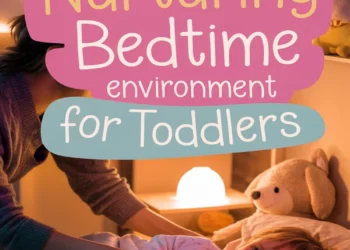Changing out of the family bed can be a tough but necessary step for both you and your child. It’s essential to understand the reasons behind this change, such as fostering independence and establishing healthy sleep patterns. Start by picking the right time and preparing your child positively for the change. Creating a comfortable sleep environment and using gradual techniques can make the process smoother. If you’re looking for effective strategies, there’s plenty more you can explore.
Understanding the Reasons for Transitioning
As your child grows, you might realize that what once felt comforting—the family bed—may not suit everyone’s needs anymore. Though co-sleeping can foster closeness, it might also lead to disrupted sleep patterns for both you and your child. Kids often need space to develop independence and learn to self-soothe, which sleeping in their own bed can encourage. It’s also natural for children to begin craving privacy as they approach school age. Additionally, moving them out of the family bed can help establish healthy sleep routines that set the foundation for good sleep hygiene. Recognizing these reasons is the first step towards making a smooth change, ensuring that everyone feels comfortable and rested in their new sleeping arrangements.
Timing the Move: When Is the Right Time?
Recognizing the reasons for moving away from the family bed helps pave the way for determining when the right moment arrives. Consider your child’s age, emotional readiness, and sleep patterns. If your child frequently expresses a desire for independence or if nighttime disruption affects everyone’s sleep, it could signal the right time. Look for signs like a consistent bedtime routine or your child’s comfort with their room. Assess your family dynamics and any upcoming changes, such as starting school or a new sibling. These changes can often provide a natural opportunity for the switch. Trust your instincts, and remember—timing is key; you want to guarantee a smooth process that supports both you and your child through this change.
Preparing the Child for the Change
When you’re ready to help your child shift out of the family bed, having an open conversation can make all the difference. Start by explaining why this change is important—both for them and for you as a parent. Reinforce their autonomy, allowing them to express any fears or concerns.
Consider these tips to ease the adjustment:
- Use a positive tone: Frame the move as an exciting adventure rather than a loss.
- Create a story: Tell a bedtime tale about a brave character who sleeps in their own cozy space.
- Involve them in preparations: Let your child choose their new bedding or decide on a cuddle toy to help ease the transition.
These steps can help them feel empowered and secure in the process.
Creating a Comfortable Sleep Environment
Once your child is ready to sleep in their own space, creating a comfortable sleep environment becomes a key focus. You’ll want to guarantee their room feels cozy and inviting. Here are some essential elements to take into account:
| Aspect | Suggestions | Benefits |
|---|---|---|
| Light | Use blackout curtains | Reduces distractions |
| Temperature | Keep it cool (68-72°F) | Promotes deeper sleep |
| Bedding | Soft sheets and blankets | Provides comfort |
Personal touches, like their favorite stuffed animal or a nightlight, can also help them feel secure. Remember, it’s all about making their sleep space a retreat they’ll look forward to at the end of the day. With these adjustments, you’ll help ease the shift beautifully.
Recommended Items
Explore our handpicked recommendations to support your family’s transition—you’re on the right path!
Establishing a Consistent Bedtime Routine
To help your child embrace their new sleeping arrangement, establishing a consistent bedtime routine is essential. This routine not only signals to your child that it’s time for sleep but also creates a sense of security. Start by introducing calming activities to wind down the day.
Consider including the following in your routine:
- Reading together: Choose a favorite book to promote relaxation and bonding.
- Gentle stretches or quiet play: This helps release any remaining energy while fostering a peaceful atmosphere.
- A warm bath: This can soothe your child and signal that bedtime is approaching.
Step-by-Step Guide to Transitioning Out of the Family Bed
Gradual Transition Techniques
As you navigate the shift out of the family bed, using gradual techniques can ease the process for both you and your child. Start by introducing a cozy sleeping area next to your bed. Gradually move your child to their own room, using the table below to guide your progression steps.
| Week | Technique | Goal |
|---|---|---|
| 1 | Side-by-side sleeping | Comfort with new space |
| 2 | Halfway across the room | Familiarity with distance |
| 3 | Shorter stays in the bed | Independence development |
| 4 | Reading time in their room | Associating space with calm |
| 5 | Full nights in their room | Establishing new routine |
Listening to your child’s needs during this time will help make the process smoother for everyone involved.
The Importance of Positive Reinforcement
While maneuvering the change out of the family bed, it’s essential to remember the power of positive reinforcement. Praising your child for every small step they take can make a significant difference in their behavior and mood. Celebrate their accomplishments and create a positive association with sleeping independently. This approach not only boosts their confidence but helps them feel secure during this shift.
- Use a reward chart to track progress and celebrate milestones.
- Give verbal praise when your child sleeps in their own bed.
- Create a special bedtime routine that emphasizes excitement for independent sleep.
Addressing Nighttime Fears and Anxiety
Even though moving to independent sleep can be exciting, it often brings up nighttime fears and anxiety for children. To help your child feel secure, create a calming bedtime routine that includes reading, cuddling, or gentle conversation. Acknowledge their fears without dismissing them, letting them know it’s okay to feel scared sometimes. Offer comfort items, like a favorite stuffed animal or a nightlight, to provide reassurance. Encourage them to express their feelings and let them know you’re just a few steps away. Use soft, soothing words to remind them of your presence and love. By validating their emotions and providing tools to cope, you can help them feel safe as they embrace this new chapter in their sleep journey.
Staying Patient and Flexible Throughout the Process
Moving into independent sleep can stir up a mix of emotions for both you and your child. It’s important to stay patient and flexible during this change. Kids often need time to adjust, and showing understanding can ease anxiety.
- Establish a consistent bedtime routine to create a sense of security.
- Be prepared for setbacks; they’re a normal part of the process.
- Offer reassurance and celebrate small victories to boost your child’s confidence.
Embracing these strategies helps you navigate challenges while fostering independence. Remember, patience goes a long way. With warmth and adaptability, this journey can strengthen your bond and encourage positive sleep habits. Trust the process and remain open to adjusting your approach as needed.













